Robert Brettell Bate, 1782 - 1847
by Brian Stevenson
last updated October, 2025
R.B. Bate operated an optical and scientific business in London during the first half of the nineteenth century. He got his start in 1804, taking over the business of his uncle and father-in-law (one in the same person), who had a commission to provide the government with hydrometers. Bate expanded the business to include microscopes and other optical equipment, plus a wide variety of other instruments. He was an optician, and so may have made at least the optical components of the microscopes, etc. that he sold. In 1833, he served as Master of the Spectaclemakers’ Guild. He was also Optician in Ordinary to King George IV and Queen Victoria (i.e. he was an official optician to the Royal Household).
Following are examples of microscopes that were produced by and/or sold by Robert Bate, his biography, then examples of other items from Bate.
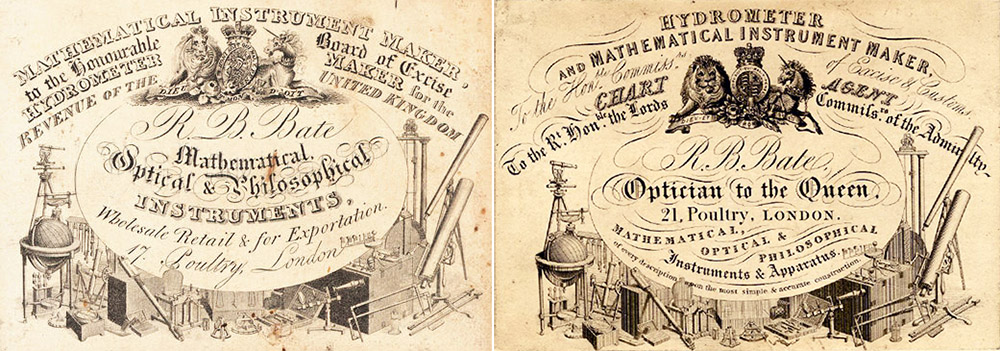
Figure 1.
Robert B. Bate trade labels. The address of 17 Poultry dates the left label to between 1807 and 1824, while the address of 21 Poultry on the right label dates it to between 1824 and 1847. Adapted for nonprofit, educational purposes from an internet sale site (left) and The British Museum (right).

Figure 2.
A case-mounted simple microscope, with aquatic adjustability, by Bate.
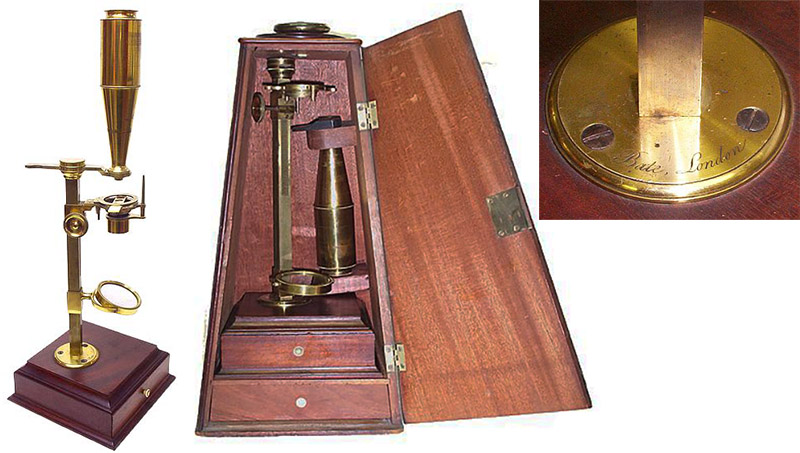
Figure 3.
A “Jones’ Improved” pattern compound microscope, by Bate. Adapted with permission from http://www.antique-microscopes.com/photos/most_improved.htm.
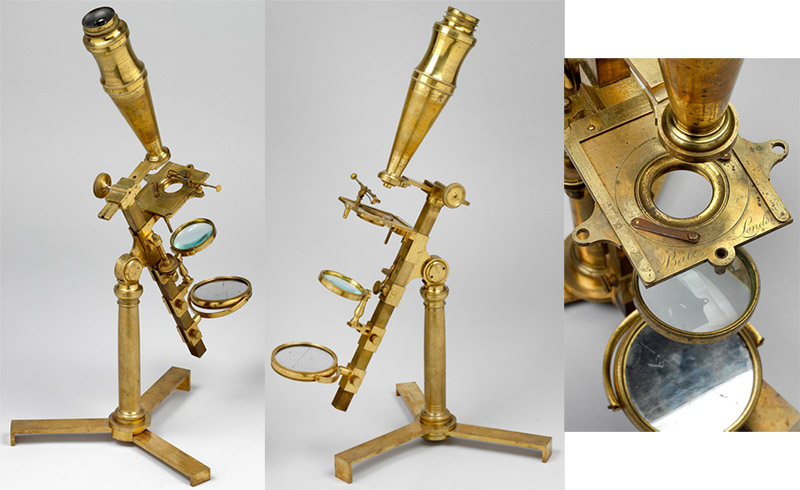
Figure 4.
A “Jones’ Most Improved” pattern microscope, by Bate. Adapted from an internet site for nonprofit, educational purposes.
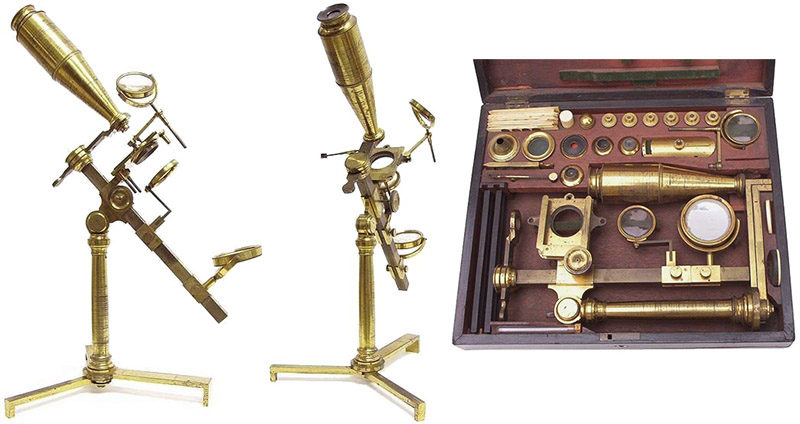
Figure 5.
Another “Jones’ Most Improved” pattern microscope, by Bate. Adapted by permission from http://www.antique-microscopes.com/mics/bate.html.
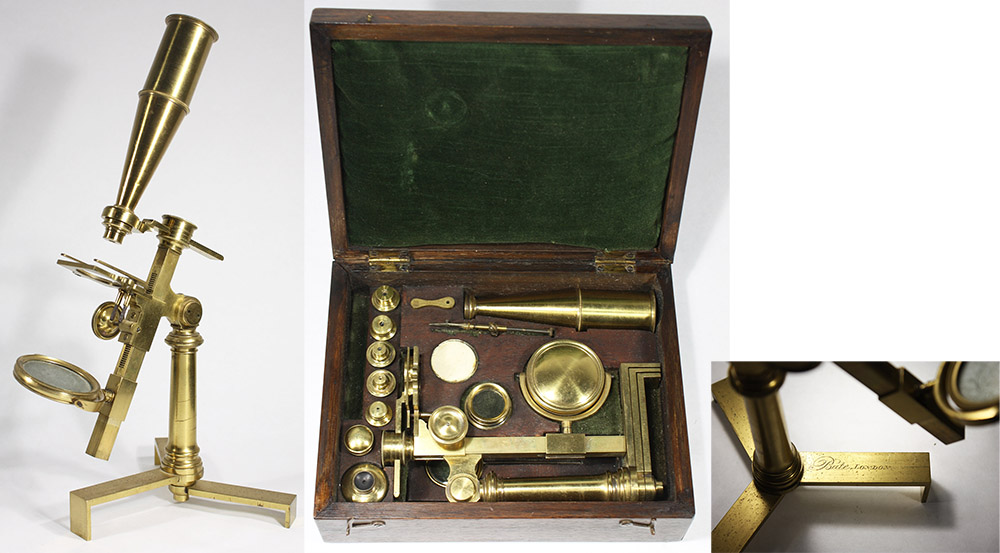
Figure 6.
A smaller, simpler “Most Improved” pattern microscope, by Bate.
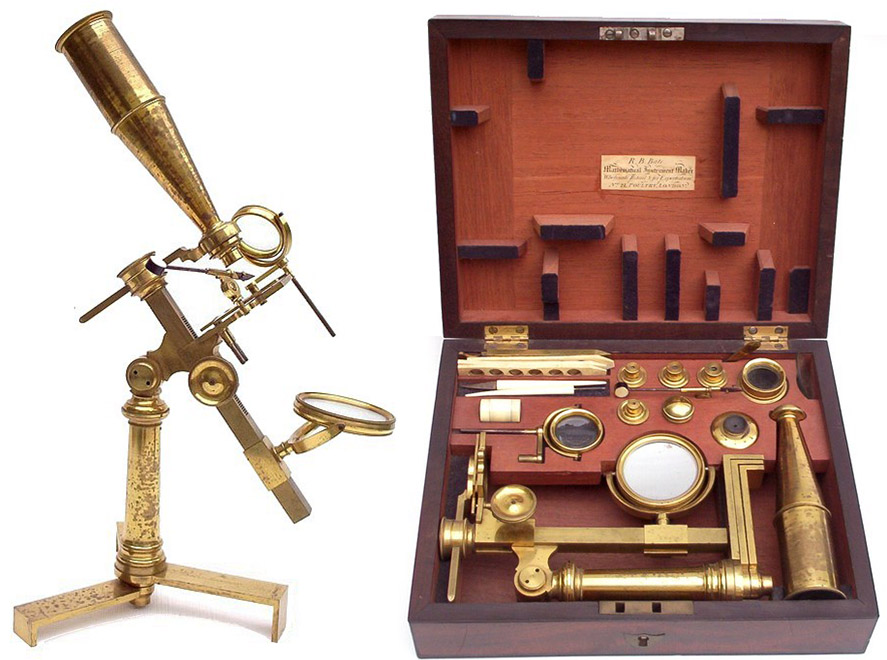
Figure 7.
Another example of Bate’s small “Most Improved”-type microscope. Adapted by permission from http://www.antique-microscopes.com/photos/small_bate.htm.

Figure 8.
A “Culpeper” type microscope, bearing a trade card from Bate. Adapted for nonprofit, educational purposes from http://collection.sciencemuseum.org.uk/objects/co118219/culpeper-type-microscope-in-brass-with-drawer-of-culpeper-microscopes.
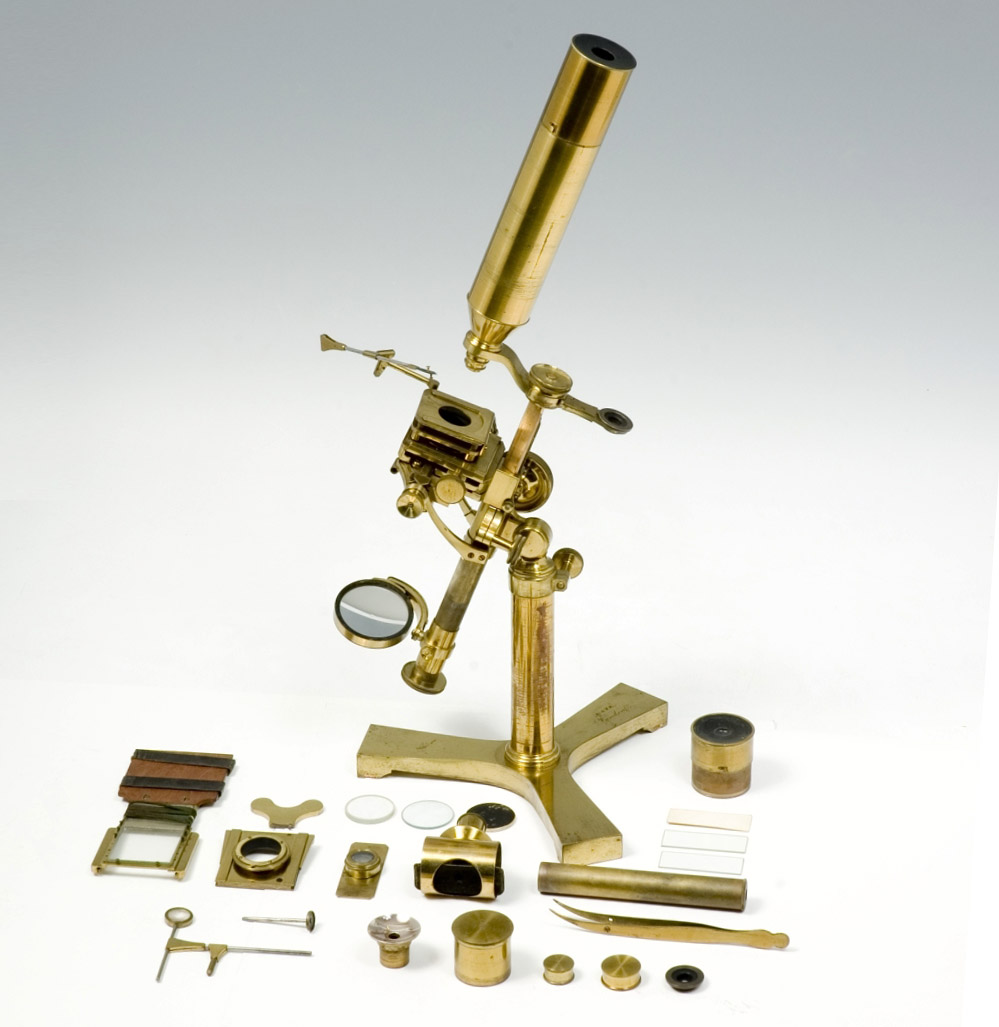
Figure 8B.
Many of the microscopes and other items sold by Bate were brought in from wholesale manufactures. This microscope is signed on the foot "Bate, London", but is recognizable as having been made by Hugh Powell (1799-1883) by comparison with other microscopes signed by Powell. (A “Culpeper” type microscope, bearing a trade card from Bate. Adapted for nonprofit, educational purposes from https://www.mhs.ox.ac.uk/collections/imu-search-page/record-details/?thumbnails=on&irn=6266&TitInventoryNo=50380.
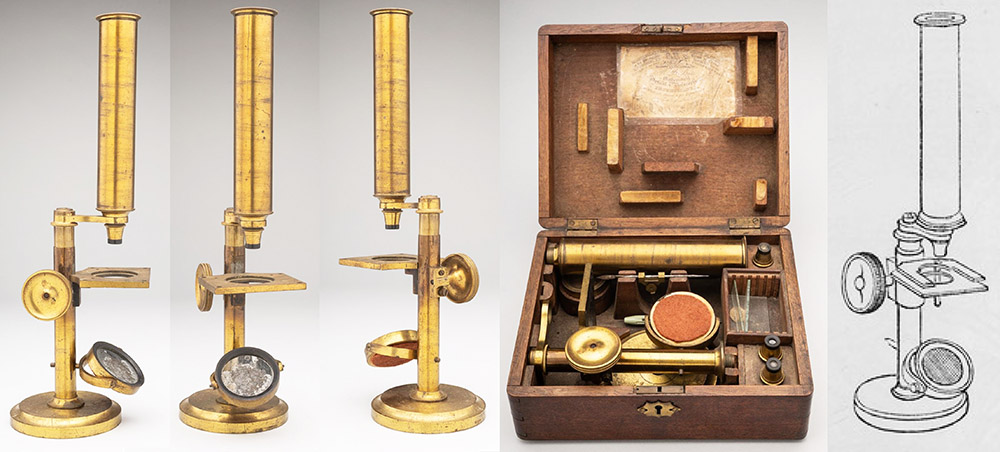
Figure 8C.
Another example of a microscope that was retailed by Bate but was almost certainly not produced by him. This model was produced by Watkins and Hill, and described in one of their catalogues as the "small-size compound microscope with stage, rackwork adjustments". An illustration from Watkins & Hill's ca. 1850 catalogue is shown to the far right. This model was also manufactured and sold by Elliott Brothers, who acquired the Watkins & Hill business in 1856. Adapted for nonprofit, educational purposes from an internet sale site.
Robert Brettell Bate was born on February 27, 1782, in Stourbridge, Worcestershire. He was the third of four children (all boys) of Overs and Susanna Bate. Overs was a banker and mercer (fabric merchant).
By 1803, Robert moved to London, to work with his uncle, Robert Brettell, who had a haberdashery at 21 Foster Lane. Our Robert became familiar with another of his mother’s siblings, Mary Sikes, who lived nearby with her husband Bartholomew and their daughter Anna Maria. This led to the marriage between Robert and Anna in February, 1804. Their first of five children was born the following December.
Anna Maria’s father had died in October, 1803. Some years earlier, Bartholomew Sikes (1731-1803) invented a hydrometer for determining the concentration of alcohol in a liquid. The “Sikes Hydrometer” was adopted as the standard measure by the Revenue Department for taxation of alcoholic drinks (Figure 10). That commission was assigned to Bate after Sikes’ death. This provided Bate with substantial income, both from the Sikes’ Hydrometers that he manufactured and sold, and from those produced by other makers throughout England.
Bate moved to 17 Poultry in 1807, a prestigious area that likely brought in affluent customers.
In 1813, the Clockmakers' Company complained that Bate was selling sundials and other time-keeping instruments on which he had engraved his name. The Clockmakers claimed that Bate needed to be a member of their guild in order to sell such merchandise, but Bate was a member of the Spectaclemakers’ guild. This led to a drawn-out dispute that was finally concluded in November, 1817, with the decision that manufacturers of sundials, clocks, etc. must be in the Clockmakers’ guild, whereas retailers, such as Bate, could be in the Spectaclemakers. It was noted that Bate “doth not make that which he sells”. Bate did, however, declare that he was a maker of spectacles, and other evidence indicates that he manufactured hydrometers on-site. It is probable that many other items that he sold where wholly or in-part brought in from other makers.
The Bate family and business moved to considerably larger premises in 1824, at 20 and 21 Poultry. He employed about twenty workers at that site.
In addition to his optical and instrument business, Bate ventured in publishing. He wrote and published numerous handbooks on the apparatus that he sold, published other writers’ works on navigation, and co-published the Nautical Magazine. In 1830, he was appointed sole agent for Admiralty charts.
Robert and Anna’s eldest child, Mary, died in 1826. Second son John died in 1840. His death was also a business setback, as he had been a major contributor to his father’s operation. Eldest son Benjamin apprenticed with his father, but left home upon completion of his training in 1829.
In his later years, Bate leased a house in Hampstead. He died there, of influenza, on December 27, 1847. He left an estate of £14,000. Anna Maria continued to operate the Bate business until 1850. She died in 1851.
The rights to publish Admiralty charts were acquired from Anna Bate in mid-1850 by John Dennett Potter (1810-1882), who had been Bate’s "shopman". The government grant for production of hydrometers and saccharometers was acquired that same year by two businesses: a partnership of the two foremen of Bate’s hydrometer/saccharometer division, Edward Ladd and John Streatfield, and by a long-time business competitor, Dring & Fage.
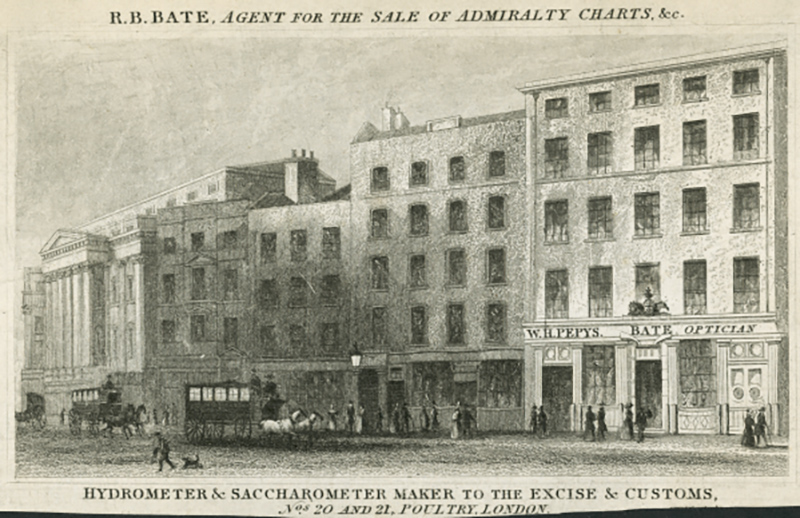
Figure 9.
Lithograph of R.B. Bate’s premises at 20-21 Poultry. He occupied this location between 1824 and 1847. From John Tallis’ "London Street Views, 1838-1840".
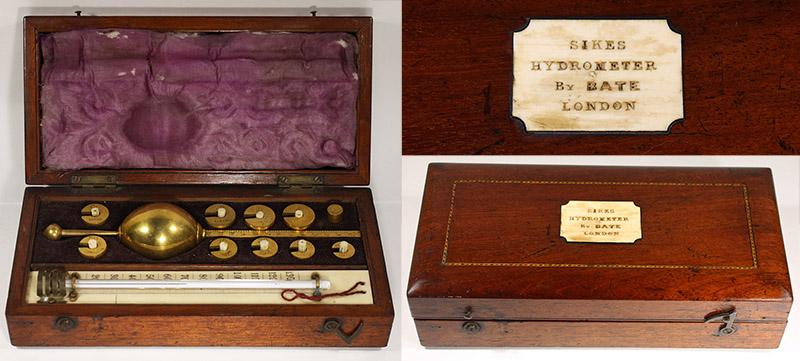
Figure 10.
A cased Sikes’ hydrometer, by R.B. Bate. Many other manufacturers also produced Sikes’ hydrometers, from which Bate collected royalties.
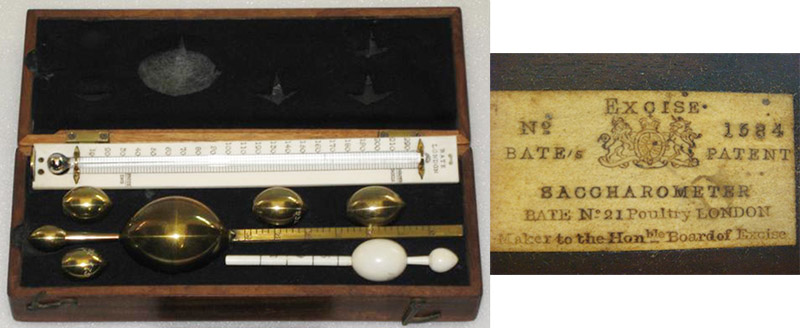
Figure 11.
A Bate saccharometer, manufactured by R.B. Bate. As with the Sikes’ hydrometers, Bate licensed production of his saccharometer to other manufacturers throughout the country. Adapted for nonprofit, educational purposes from http://collectionsonline.nmsi.ac.uk.
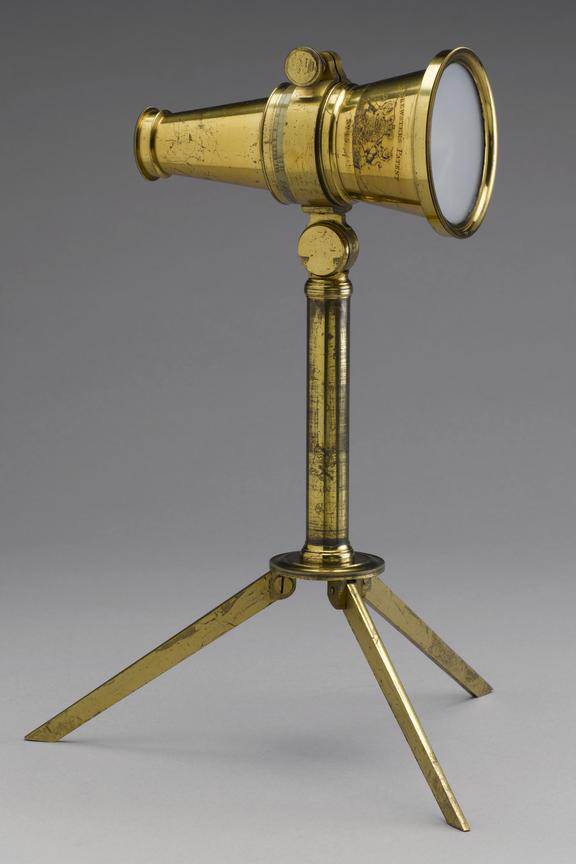
Figure 12.
A kaleidoscope by Bate, engraved with the royal crest and “Dr Brewster's Patent”. Bate collaborated with David Brewster on its development. Adapted for nonprofit, educational purposes from The National Science Museum, http://collection.sciencemuseum.org.uk/objects/co3905/brewster-type-kaleidoscope-on-tripod-mount-by-rob-kaleidoscope.
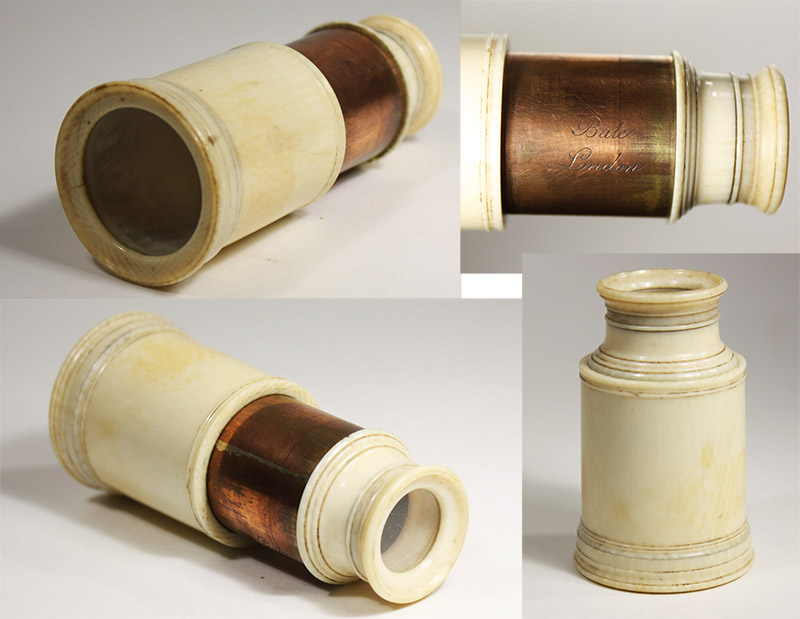
Figure 13.
An ivory and brass prospect glass (a low power telescope for the theater or for peeping on other people at events), signed by Bate. Fully extended, it is about 3 1/4 inches / 8 cm long.
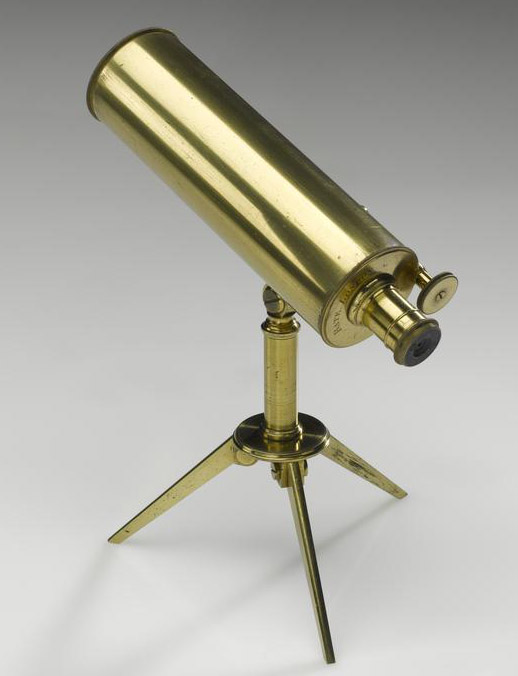
Figure 14.
Gregorian reflecting telescope with 2 1/2 inch aperture and 8 inch focal length, by Bate. Adapted for nonprofit, educational purposes from http://collection.sciencemuseum.org.uk/objects/co56637/gregorian-reflecting-telescope-of-2-12-inch-apert-telescope-gregorian-telescope-reflecting.
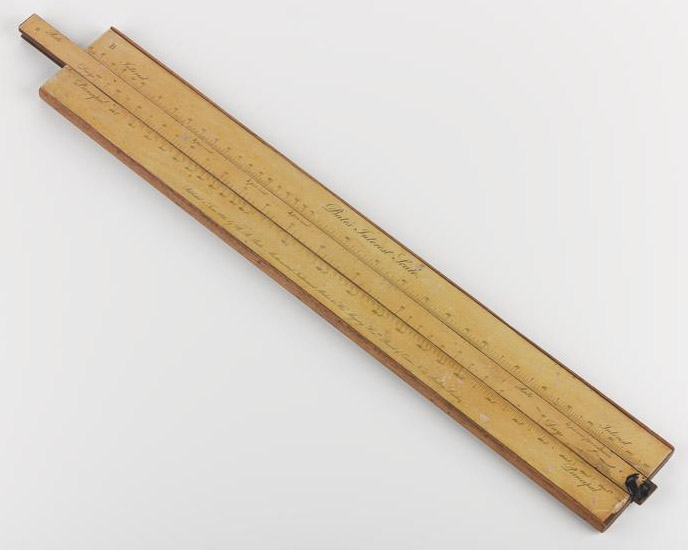
Figure 15.
“Bate's Interest Scale” slide-rule, ca. 1824. Paper scales on wood, measuring 18 7/8 inches (47 cm) long. Adapted for nonprofit, educational purposes from http://collection.sciencemuseum.org.uk/objects/co60229/slide-rule-for-interest-calculations-ready-reckoners.
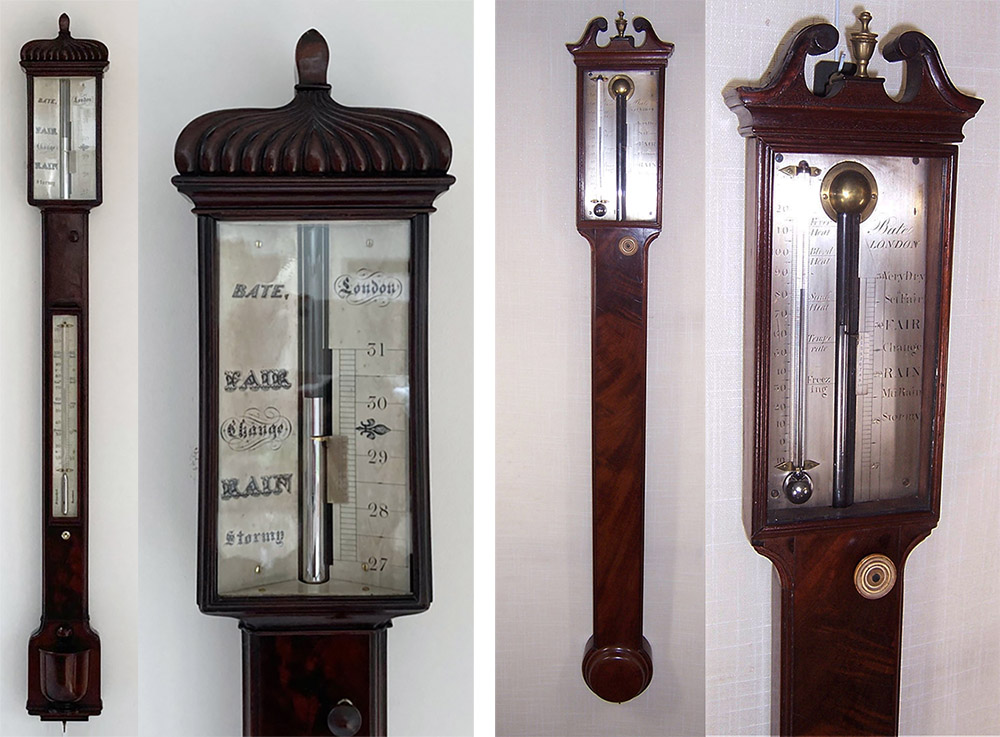
Figure 16.
Two barometers by Bate. Adapted for nonprofit, educational purposes from internet sale sites.
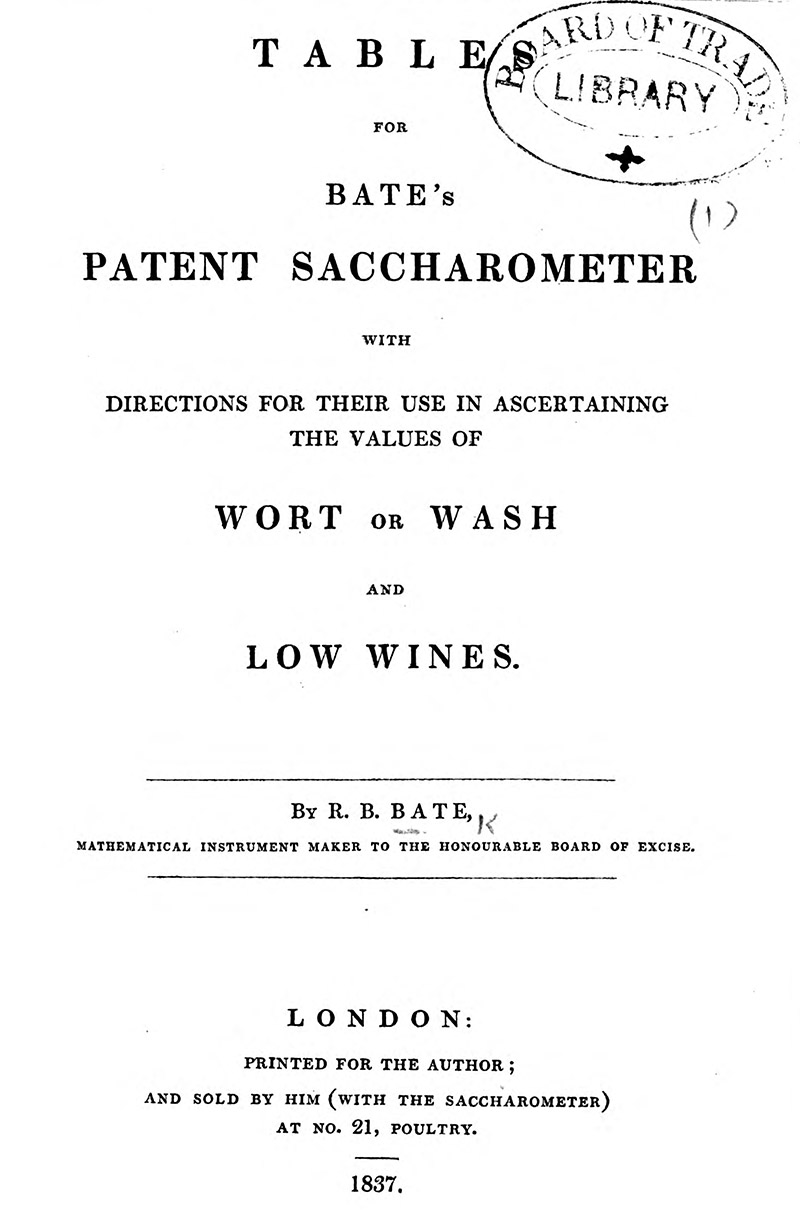
Figure 17.
Pocket globe by Bate, dated 1818. Adapted for nonprofit, educational purposes from an internet auction site.
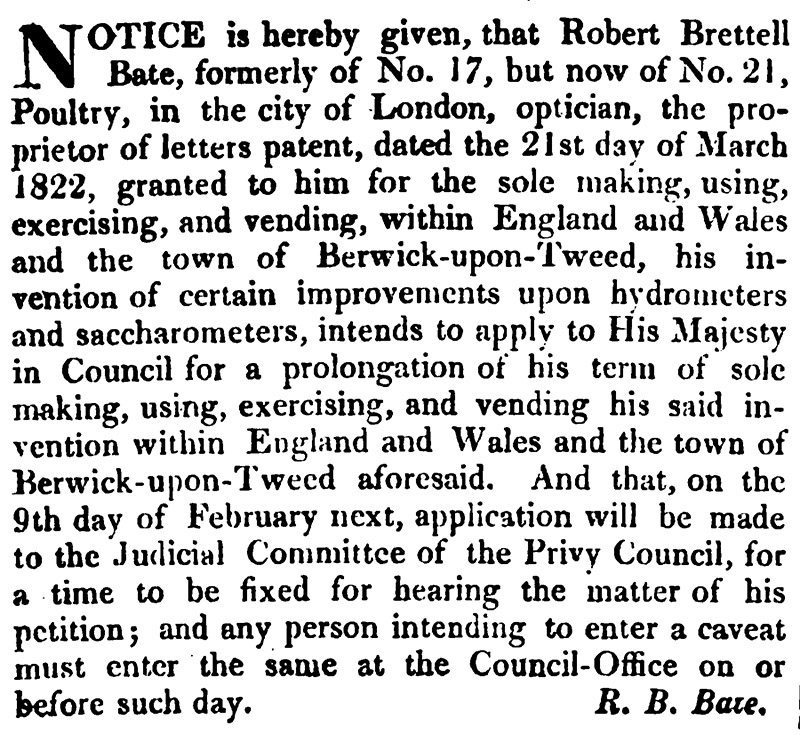
Figure 18.
Front page of the 1837 edition of “Tables for Bate’s Patent Saccharometer”, published by Bate.
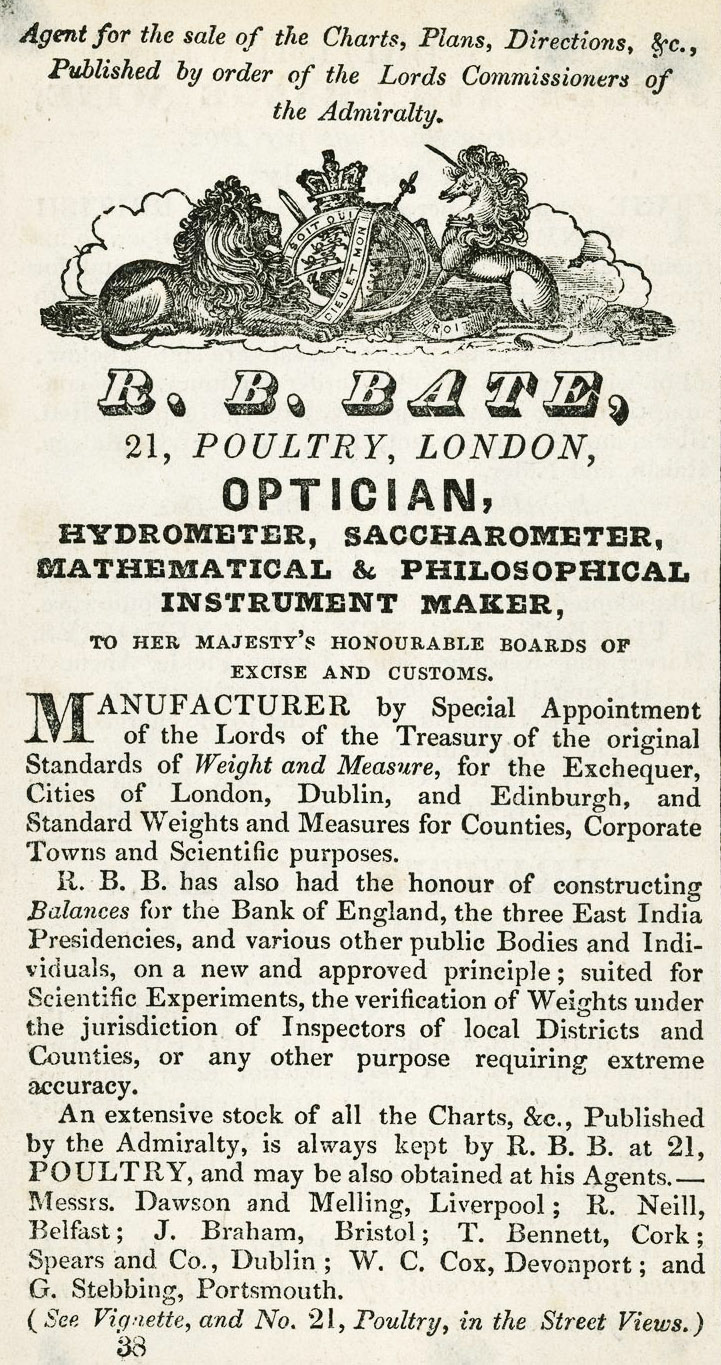
Figure 19.
1836 application by R.B. Bate to renew his 1822 patents on hydrometers and saccharometers. From ‘The London Gazette’.

Figure 20.
ca. 1840 advertisement by R.B. Bate. Adapted for nonprofit, educational purposes from https://collection.sciencemuseumgroup.org.uk/objects/co8015819/r-b-bate-trade-card-advertisement.
Acknowledgements
Thank you to Allan Wissner for permission to use images of microscopes from his collection, and for generously sharing them with the public on his web site, http://www.antique-microscopes.com.
Resources
Birth record of Robert Brettell Bate (1782) accessed through familysearch.org
England records of births, marriages, and other vital information, accessed through ancestry.com
London Gazette (1836) page 44
McConnell, Anita (2004) Bate, Robert Brettell (1782-1847), Oxford Dictionary of National Biography
McConnell, Anita (1993) R.B. Bate of the Poultry, 1782-1847, The Life and Times of a Scientific Instrument Maker, Scientific Instrument Society, London
Newcastle Magazine (1826) Memoir of the late Mr. Bartholomew Sikes, Vol. 5, pages 387-391
Tallis, John (2002) John Tallis's London street views, 1838-1840 : together with the revised and enlarged views of 1847 / introduced and with a biographical essay by Peter Jackson, London Topographical Society, page 116
Usselman, Melvyn C. (2015) Pure Intelligence: The Life of William Hyde Wollaston, University of Chicago Press, Chicago





















